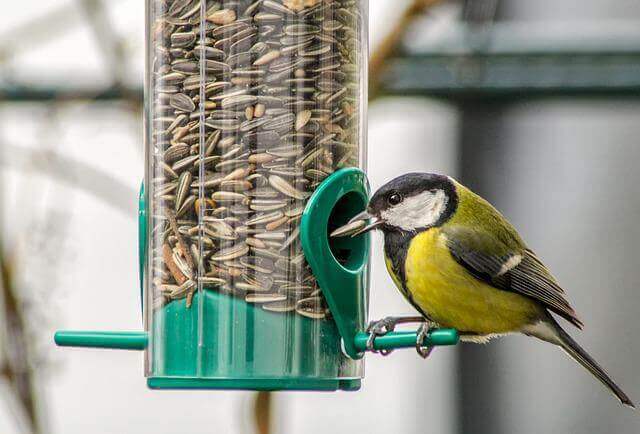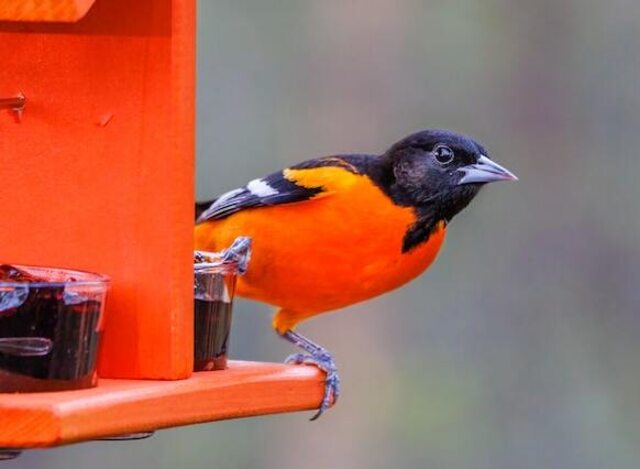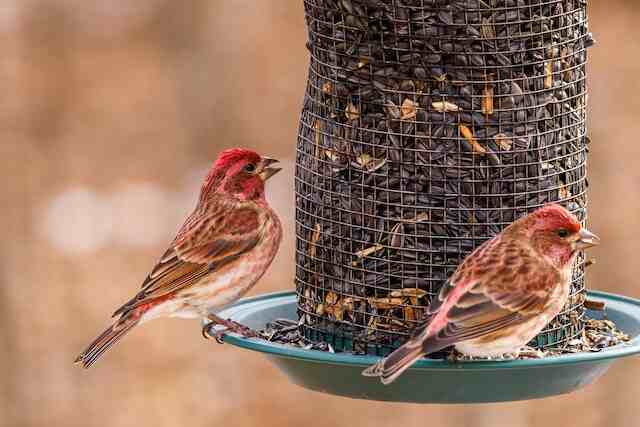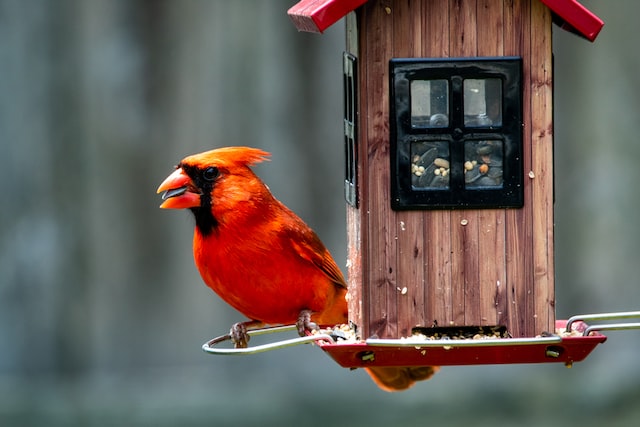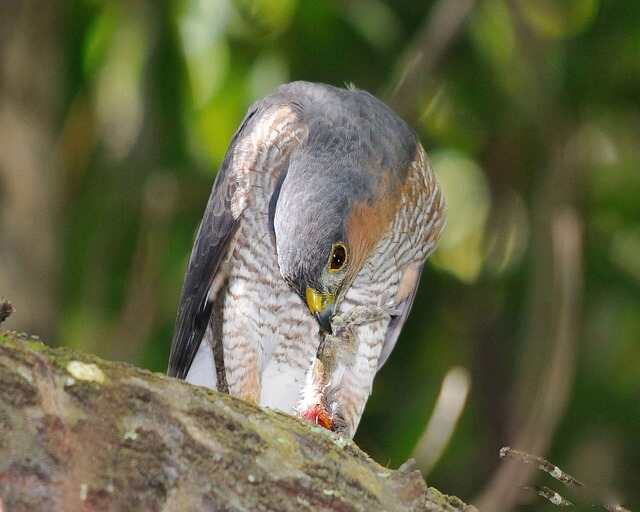As a bird enthusiast, I have always been intrigued by the fascinating world of avian senses. One of the most curious questions that have come across my mind is whether birds have the ability to smell bird seed. In this article we will explore the science of bird olfaction and examine the avian olfactory abilities to determine if birds can detect the scent of bird seed.
Many bird owners and enthusiasts believe that birds can smell bird seed, but is it true? While it is a common belief, scientific evidence suggests that bird olfaction is not as powerful as that of other animals. However, birds do have some ability to detect odors, including the scent of their food source.
The sense of smell in birds is not as well developed as it is in mammals. Birds have fewer olfactory receptor cells, and their olfactory bulb is smaller, which means their sense of smell is not as acute. However, some studies suggest that certain bird species have a keen sense of smell that plays a significant role in foraging and communication.
Table of Contents
- 1 Key Takeaways:
- 2 Can Birds Smell Bird Seed?
- 3 The Science of Olfaction in Birds
- 4 Bird Foraging Behaviors
- 5 Attracting Birds with Scented Bird Seed
- 6 Comparing Avian Olfaction to Other Senses
- 7 Bird Seed Preferences and Olfactory Cues
- 8 The Role of Olfaction in Avian Evolution
- 9 Bird Behavior and Seed Smell
- 10 Bird Seed Ingredients and Olfactory Signatures
- 11 Practical Tips for Attracting Birds with Scented Seed
- 12 Can Birds Detect Scents in Bird Seed?
- 13 Conclusion
- 14 FAQs
- 14.1 How do birds detect and interpret odors?
- 14.2 Do birds use scent detection to find food?
- 14.3 Can scented bird seed attract birds?
- 14.4 How does avian olfaction compare to other senses?
- 14.5 Can certain smells attract specific bird species?
- 14.6 What role does olfaction play in avian evolution?
- 14.7 How does bird behavior respond to the smell of bird seed?
- 14.8 Can birds detect different odors emitted by bird seed ingredients?
- 14.9 What are some practical tips for attracting birds with scented seed?
- 14.10 How much can birds detect scents in bird seed?
- 15 Author
Key Takeaways:
- Birds have a weaker sense of smell compared to mammals
- Scientific evidence suggests that birds have some ability to detect odors, including bird seed smell
- Avian olfactory abilities vary among species
- Bird behavior and feeding patterns may be influenced by certain scents in bird seed
- Understanding the role of olfaction in birds can help attract and appreciate these fascinating creatures in our environment
Can Birds Smell Bird Seed?
Birds possess olfactory capabilities, but the extent varies among species. While not all birds have a highly developed sense of smell, some, like vultures and kiwis, rely on it for various aspects of their lives.
However, for many common backyard birds, vision and other senses play a more significant role in finding food. The odor of birdseed might not be a primary attractant for them. Instead, they tend to locate food sources using visual cues and memory.
Birdseed quality and freshness are essential for attracting birds, but it’s typically their visual and auditory senses, rather than smell, that guide them to feeders. So, while some birds can detect scents, it’s not the primary means by which most birds find their birdseed.
The Science of Olfaction in Birds
When we think of birds, we often associate them with their remarkable visual abilities. However, many birds also have a keen sense of smell, or olfaction, that plays an important role in their sensory perception and foraging behaviors.
The olfactory system in birds is situated in the upper part of the beak and is connected to the nasal cavity. Unlike mammals, birds do not have a separate olfactory bulb in the brain, but rather a cluster of olfactory receptors located in the nasal cavity.
Despite this structural difference, birds have been shown to detect and respond to a wide range of odors, including those related to food, predators, and mates. In fact, many bird species have been found to use olfaction as a primary method of locating food sources, particularly in low-light or poor visual conditions.
The Evolution of Avian Olfaction
The olfactory abilities of birds have likely evolved in response to ecological pressures and environmental factors. For example, birds that live in densely vegetated habitats or areas with low visual clarity may rely more heavily on olfaction to locate prey. Similarly, birds that migrate over long distances may use olfactory cues to navigate and find suitable breeding sites.
Overall, the olfactory system in birds is complex and varied, with different species exhibiting different levels of sensitivity and preference for specific odors. By understanding the role of olfaction in birds, we can gain a deeper appreciation for these fascinating creatures and their unique sensory abilities.
Bird Foraging Behaviors
When it comes to locating food sources, birds use a variety of foraging strategies. These behaviors are influenced by a number of factors, including the availability of food, competition with other birds, and the bird’s individual preferences and abilities. One important aspect of bird foraging is the use of scent detection to locate and select suitable seeds for consumption.
Birds have a remarkable ability to detect scents, though they rely more heavily on their visual and auditory senses for survival. Nevertheless, scent detection is an important tool in a bird’s foraging arsenal, as it allows them to locate food sources that might be otherwise hidden from view.
Bird Scent Detection
So how exactly do birds detect scents? Like most animals, birds have specialized olfactory receptors located in their nasal passages. These receptors are sensitive to specific chemical compounds found in odors, and when triggered, they send signals to the brain for interpretation.
Some birds, such as vultures, have an especially keen sense of smell, which they use to locate carrion from great distances. However, even birds with less developed olfactory abilities can use scent detection to find food. For example, some birds can use the smell of insects to locate their hiding spots, while others can detect the scent of ripe fruit or seeds.
Bird Foraging Strategies
When it comes to foraging for seeds, birds use a number of strategies to find and select the best food sources. Some birds, such as finches, have specialized beaks that allow them to crack open tough seed shells. Other birds, such as sparrows, prefer to feed on smaller, softer seeds that can be easily swallowed.
Regardless of their individual feeding preferences, birds will use their sense of smell to locate suitable seeds. This might involve hovering over a potential food source, sniffing the air to detect its scent. Other birds may use their sense of smell to track the movements of other birds who have already located a food source, following their scent trail to the site.
Table: Common Bird Foraging Behaviors
| Bird Species | Foraging Behavior |
|---|---|
| Finches | Crack open tough seed shells with specialized beaks |
| Sparrows | Feed on smaller, softer seeds that can be easily swallowed |
| Woodpeckers | Drill into wood to extract insects and larvae |
| Hummingbirds | Feed on nectar from flowers using long, specialized tongues |
Overall, scent detection plays an important role in the foraging behaviors of birds, allowing them to locate and select suitable food sources. By understanding the nuances of bird behavior and olfactory preferences, we can better attract and appreciate these remarkable creatures in our surroundings.
Attracting Birds with Scented Bird Seed
If you’re a bird enthusiast and looking to attract feathered friends to your garden, there are several bird seed attractants you can use. One of the most effective methods is using scented bird seed.
Attracting birds with scented seed involves adding fragrances that birds find appealing and can detect through their olfactory senses. These fragrances can be added to the bird seed in various ways.
The Types of Scented Bird Seed Attractants
There are several types of bird seed attractants available, each with their unique scents and benefits. Here are a few examples:
- Anise oil: This essential oil has a sweet licorice aroma that many bird species find irresistible.
- Citrus oil: This oil is derived from the rind of citrus fruits and has a refreshing scent that can attract a variety of bird species.
- Peanut butter: This creamy and nutty spread can be used to coat bird seed, creating a scent that attracts birds that enjoy nuts.
When choosing a scented bird seed, it’s important to select scents that are appealing to the birds you’re hoping to attract. For example, if you’re trying to attract finches, you might want to choose an anise oil scented seed, whereas if you’re hoping to attract blue jays, peanut butter scented seed might be more effective.
Crafting the Perfect Bird Seed Blend
Aside from scented bird seed, you can also create your own bird seed blend, which can also attract birds through scent. To do this, start with a base seed, such as sunflower or millet, and add scented ingredients to it, such as crushed herbs or fruit extracts. Be sure to avoid adding any ingredients that may be harmful to birds.
Here’s an example of a simple DIY bird seed blend:
| Ingredient | Amount |
|---|---|
| Sunflower seeds | 2 cups |
| Millet | 1 cup |
| Crushed lavender | 2 tablespoons |
| Orange zest | 1 tablespoon |
By creating your bird seed blends, you can customize the scent and nutritional value of the seed, thus, attracting a wider range of bird species.
Creating an Inviting Environment
In addition to using scented seed, creating an inviting environment is crucial to attracting birds. Ensure they have access to water for drinking and bathing, shelter such as bushes and trees, and nesting boxes. Bird feeders should be placed in locations that are visible to birds but not too close to windows to avoid bird collisions.
With these tips in mind, you can use scented bird seed to attract a variety of bird species to your garden, creating a haven for these beautiful creatures.
Comparing Avian Olfaction to Other Senses
When it comes to foraging and survival, birds rely on various senses to navigate their environment and locate food sources. While vision is often thought of as the primary sense for birds, their olfactory capabilities also play a significant role in these activities.
Compared to other species, however, birds do not have a well-developed sense of smell. In fact, their olfactory bulbs, the part of the brain responsible for processing scent information, are relatively small compared to other vertebrates. This has led some researchers to suggest that birds rely more on visual and auditory cues for navigation and social communication.
Despite this, birds are still able to detect and interpret certain odors, particularly those related to food sources. Studies have shown that birds are able to distinguish between different types of seeds based on their odors, and they are more likely to choose those with a pleasant smell.
The Role of Olfaction in Foraging
When it comes to foraging, birds may use their sense of smell in conjunction with their vision and other senses to locate food sources. For instance, some species of birds have been observed using scent trails to find food, particularly in situations where the food is not visible.
Additionally, birds may use olfactory cues to identify and locate specific plants or insects that are part of their diet. This ability to detect and target specific food sources can be especially important for migratory birds, which need to conserve energy and find food quickly in unfamiliar environments.
Olfaction vs. Vision
While birds rely heavily on their vision for many activities, the sense of smell can provide a unique set of advantages. For example, olfaction can help birds locate food sources that are out of sight, such as underground seeds or hidden insects. In some cases, it may also allow them to detect predators or other potential dangers before they are visible.
However, visual cues also play an important role for birds, particularly in social communication and mating behaviors. Birds use visual cues to identify potential mates, display dominance, and establish territory boundaries. Their keen eyesight also allows them to navigate during migration, detect predators, and locate food sources.
Summary
While birds may not rely as heavily on olfaction as some other species, their sense of smell still plays an important role in their foraging and survival strategies. By understanding the ways in which birds use olfactory cues to locate food and navigate their environment, we can gain a greater appreciation for their remarkable abilities and the complex ways in which they interact with their surroundings.
Bird Seed Preferences and Olfactory Cues
When it comes to selecting their food, birds rely on a variety of sensory cues, including visual, auditory, and olfactory signals. Olfaction, the sense of smell, plays a critical role in helping birds locate and identify potential food sources.
Research has shown that different bird species have varying preferences for certain seed smells. For example, the smell of vanilla has been found to attract titmice, while blue jays are drawn to the smell of peanuts. The scent of sunflower seeds, on the other hand, is attractive to a wide range of bird species.
Factors That Influence Bird Seed Preferences
There are several factors that can influence a bird’s preference for a particular type of bird seed. These can include:
- The bird’s species and diet
- The bird’s previous foraging experiences and memories
- The concentration and quality of the scent emitted by the seed
- The availability of other food sources in the vicinity
Understanding these factors can be helpful when choosing bird seed to attract specific bird species to your garden or backyard. However, it’s important to note that even within a particular species, individual birds may have different preferences for certain seed smells.
Attracting Birds with Scented Seed
If you’re interested in attracting birds to your outdoor space, using scented bird seed can be an effective strategy. To increase your chances of success, consider the following tips:
- Choose high-quality bird seed with a strong, appealing scent.
- Offer seed in a variety of feeders, including hanging feeders and ground-level platforms.
- Place feeders in locations with ample cover and protection from predators.
- Keep feeders clean and well-maintained to prevent spoilage and bacterial growth.
By using these strategies, you can increase the likelihood that birds will detect and be attracted to the scent of the bird seed you provide.
The Role of Olfaction in Avian Evolution
Understanding the role of olfaction in avian evolution is crucial to appreciating the remarkable abilities of birds. While olfaction is not as dominant in birds as it is in some mammals, it has played a significant role in the evolution of various bird species.
As birds evolved, their sense of smell became less important compared to their visual and auditory senses. However, there are still many species of birds that rely on olfaction to locate food and navigate their environment.
One of the most notable examples of olfaction in birds is the ability of seabirds to locate their nesting sites. Many species of seabirds rely on their sense of smell to find their way back to their burrows or nests, which can be located in crowded colonies where visual cues are limited.
Comparing Avian Olfaction to Other Senses
The role of olfaction in avian evolution is especially fascinating when compared to other senses, such as vision. While birds have highly developed visual senses, their olfactory systems are often less prominent. This is because birds rely heavily on their sight to navigate their environment, locate food, and identify predators.
However, despite the comparative de-emphasis on olfaction, birds have still evolved a range of adaptations that facilitate their sense of smell. For example, some species of birds have highly developed olfactory bulbs, which enable them to detect and interpret a wide range of odors.
Avian Olfaction and Foraging Behaviors
The role of olfaction in avian evolution is particularly evident in the foraging behaviors of various bird species. Many birds use their sense of smell to locate food sources, such as seeds or insects, based on olfactory cues.
Some species of birds have developed highly specialized olfactory systems that enable them to detect specific odors, while others rely on broader olfactory cues to locate food. For example, some species of birds like hummingbirds can detect the scent of certain flowers, which indicates the presence of nectar.
The Evolution of Avian Olfaction
Understanding the role of olfaction in avian evolution has been an area of active research for many years. While we may still have much to learn about the evolution of olfactory systems in birds, scientists have made significant strides in recent years in understanding the role of olfaction in avian behavior and survival strategies.
Some of the key insights gained from these studies include a better understanding of how different bird species use olfactory cues to navigate their environment, locate food sources, and identify potential threats.
Summary
The role of olfaction in avian evolution is an intriguing area of study that sheds light on the remarkable abilities of birds. Understanding how birds use their sense of smell to forage and navigate their environment can help us appreciate the remarkable adaptations of these creatures, and provide insights into how we can best support them in our surroundings.
Bird Behavior and Seed Smell
One of the fascinating aspects of bird behavior is the influence of olfaction on their feeding patterns. While birds rely mostly on their eyesight and hearing to locate food sources, their olfactory senses can play a significant role in seed selection and consumption.
Studies have shown that certain bird species have the ability to detect specific odors in their food, which can affect their feeding behavior. For instance, the smell of mint can deter house sparrows from eating birdseed, while the scent of anise can attract finches.
Additionally, some bird species have been shown to prefer certain odors in their food. For example, some species of woodpeckers have a preference for nuts with a strong cedar-like smell. Interestingly, these preferences are not necessarily related to the nutritional content of the food, but rather to the olfactory signature of the seed.
The relationship between bird behavior and seed smell highlights the importance of understanding the olfactory preferences of different bird species when selecting bird seed for your garden. By choosing seed blends that contain smells that attract your desired bird species, you can increase the likelihood of attracting and supporting a diverse range of birds in your backyard.
Bird Seed Ingredients and Olfactory Signatures
One of the factors that can influence a bird’s selection of seed is its olfactory signature. Different seed ingredients can emit specific odors that birds can detect and be attracted to. Let’s explore some of the most common bird seed ingredients and their olfactory cues:
| Seed Ingredient | Olfactory Signature |
|---|---|
| Sunflower Seeds | The aroma of fresh sunflower seeds is known to attract birds like finches and cardinals. The smell is nutty and slightly sweet. |
| Safflower Seeds | Safflower seeds have a mild, slightly earthy aroma that’s not as strong as sunflower seeds. They are often preferred by birds like doves and sparrows. |
| Thistle (Nyjer) Seeds | Thistle seeds have a strong nutty odor that attracts finches and other small songbirds. Not all birds can detect thistle seeds, so they are a great choice for targeting specific bird species. |
| Corn | Many birds are drawn to the sweet, slightly earthy aroma of corn. It’s a common ingredient in many bird seed mixes and can attract birds like doves, jays, and blackbirds. |
| Millet | Millet has a mild, slightly grassy aroma that’s not as strong as other seed ingredients. It’s often preferred by smaller birds like finches and sparrows. |
The Power of Olfactory Cues
By understanding the olfactory preferences of different bird species, we can tailor our bird seed offerings to attract specific birds to our gardens. It’s important to note that scent isn’t the only factor that birds use to select food sources; factors like color, texture, and taste are also important. However, by adding different seed ingredients with distinct olfactory signatures, we can create a diverse and appealing buffet for our feathered friends.
Practical Tips for Attracting Birds with Scented Seed
Are you looking to attract more birds to your garden? Scented bird seed can be an effective way to bring in a variety of bird species. Here are some practical tips for using scented seed to attract birds:
- Select the right seed: Different bird species have different preferences when it comes to seed type and scent. Research which types of birds are common in your area and what scents they are attracted to. For example, finches are attracted to thistle seed with a sweet, musky scent, while chickadees prefer sunflower seeds with a nutty aroma.
- Provide a variety of feeders: Different birds have different feeding preferences, such as hanging feeders, tube feeders, and platform feeders. By providing a variety of feeders, you can attract a wider range of bird species to your garden.
- Place feeders strategically: Birds prefer feeders that are placed in a safe and open location away from predators. Place feeders at different heights and distances from trees, bushes, and other structures to attract a diverse range of birds.
- Keep feeders clean: Dirty feeders can spread disease and bacteria and discourage birds from feeding. Clean your feeders regularly with soap and water, and disinfect them with a solution of one part vinegar to nine parts water.
- Plant bird-friendly vegetation: Some plants can provide both food and shelter for birds. Consider planting native trees, shrubs, and flowers that produce seeds, berries, and nectar to attract birds to your garden.
- Provide a water source: Birds need water for drinking and bathing. Provide a shallow bird bath or fountain that is cleaned regularly and filled with fresh water.
- Use caution with scents: While scented seed can attract birds, strong scents can also be overwhelming and harmful to birds. Use scented seed sparingly and avoid using artificial or strong scents that can be harmful to birds.
By following these practical tips, you can create an inviting environment for birds and enjoy the beauty and diversity of avian visitors in your garden.
Can Birds Detect Scents in Bird Seed?
One of the most fascinating questions about avian olfactory abilities is whether birds can detect scents in bird seed. While birds are not typically known for their sense of smell, recent research suggests that they may be able to detect certain odors in food sources.
One study published in the journal Nature found that birds can detect the smell of their preferred foods, even when those foods are mixed in with other, less desirable options. The study’s authors suggest that birds may use their sense of smell to locate and identify suitable food sources, especially in situations where visual cues are not sufficient.
However, this ability may not be universal among all bird species. Some birds, such as vultures and kiwis, are known for their highly developed sense of smell, while others rely more on visual and auditory cues.
Overall, the scientific evidence suggests that while birds may not rely heavily on olfaction compared to other senses, they are capable of detecting certain scents in their food, including in bird seed.
Conclusion
In this article, I have explored the question of whether birds have the ability to smell bird seed. Through a deep dive into the world of avian olfactory senses, I have uncovered the truth behind bird seed detection.
We have discussed the science behind olfaction in birds and how it compares to other senses, as well as the role of olfaction in avian evolution. We have also explored how bird foraging behaviors are influenced by olfactory cues and how scented bird seed can be used as a method to attract birds.
Furthermore, we have examined the relationship between bird seed ingredients and their olfactory signatures, as well as the connection between bird behavior and the smell of bird seed. We have also provided practical tips for using scented bird seed to attract birds to your garden.
Finally, we addressed the central question of whether birds have the ability to detect scents in bird seed, and determined that while birds may not rely heavily on olfaction compared to other senses, they do have the ability to detect certain scents in bird seed, which can influence their foraging behaviors.
Appreciating the Remarkable Creatures
Understanding the role of olfaction in birds can help us better appreciate and attract these remarkable creatures in our surroundings. By providing suitable bird seed and creating an inviting environment, we can encourage bird populations to flourish and bring a little bit of nature into our everyday lives.
So, let us continue to explore the fascinating world of avian olfactory senses and work towards a better understanding and appreciation of the avian species.
FAQs
How do birds detect and interpret odors?
Birds detect and interpret odors through their olfactory receptors, which are located in their nasal passages. These receptors send signals to the brain, allowing birds to identify and respond to different scents.
Do birds use scent detection to find food?
Yes, birds use scent detection as one of the methods to locate food sources. They can rely on their olfactory senses to identify suitable seeds for consumption.
Can scented bird seed attract birds?
Yes, scented bird seed can be used as a method to attract birds. Certain scents can appeal to specific bird species and enhance their foraging behaviors.
How does avian olfaction compare to other senses?
Avian olfaction works alongside other senses, such as vision, to aid birds in foraging and survival. While birds may not heavily rely on olfaction alone, it still plays a significant role in their sensory perception.
Can certain smells attract specific bird species?
Yes, specific smells can attract certain bird species. Different bird species may have preferences for certain odors, which can influence their feeding behaviors.
What role does olfaction play in avian evolution?
Olfaction has played a role in the evolution of birds, shaping their behavior and survival strategies over time. The ability to detect scents has aided birds in finding food sources and avoiding potential dangers.
How does bird behavior respond to the smell of bird seed?
Birds’ response to the smell of bird seed can impact their feeding patterns and interactions with other birds. Certain smells can attract or repel specific bird species, influencing their behavior.
Can birds detect different odors emitted by bird seed ingredients?
Yes, bird seed ingredients can emit specific odors that birds can detect. Different seed components may have distinct olfactory signatures that attract birds.
What are some practical tips for attracting birds with scented seed?
Some practical tips for attracting birds with scented seed include selecting the right seed that appeals to your target bird species, creating an inviting environment with appropriate feeders and shelter, and maintaining a clean feeding area.
How much can birds detect scents in bird seed?
Birds have the ability to detect certain scents in bird seed, although their olfactory capabilities may not be as strong as other senses. Scientific studies have shown that birds can detect and respond to scents in their environment, including those found in bird seed.


